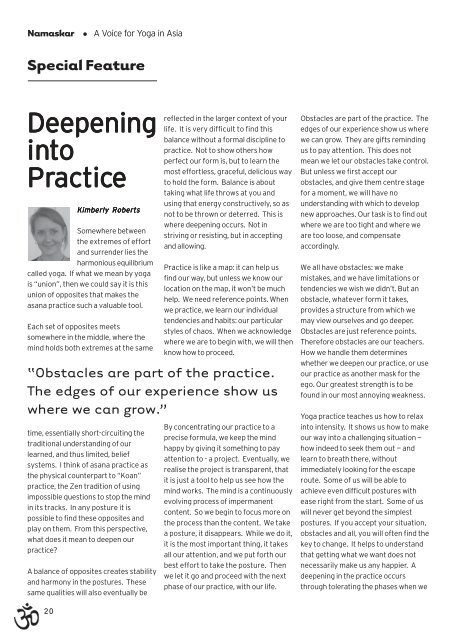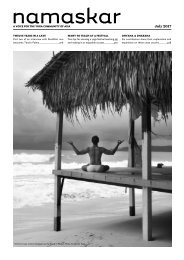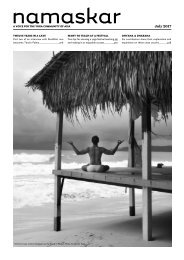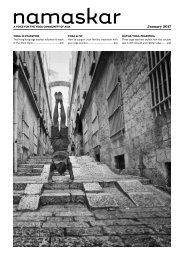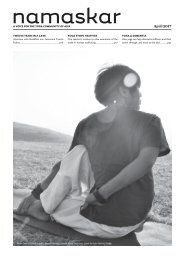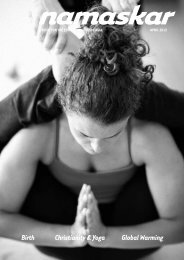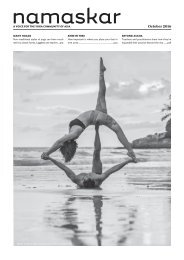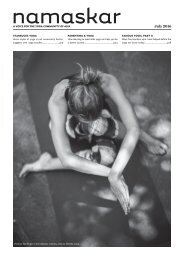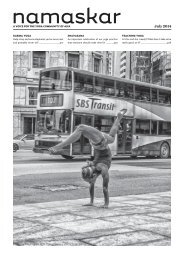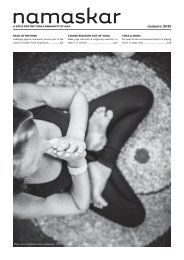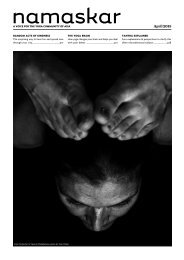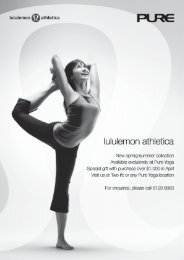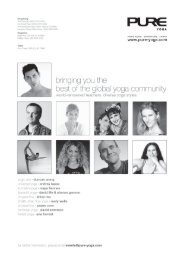You also want an ePaper? Increase the reach of your titles
YUMPU automatically turns print PDFs into web optimized ePapers that Google loves.
<strong>Namaskar</strong> • A Voice for Yoga in Asia<br />
Special Feature<br />
Deepening<br />
into<br />
Practic<br />
actice<br />
Kimberly Roberts<br />
Somewhere between<br />
the extremes of effort<br />
and surrender lies the<br />
harmonious equilibrium<br />
called yoga. If what we mean by yoga<br />
is “union”, then we could say it is this<br />
union of opposites that makes the<br />
asana practice such a valuable tool.<br />
Each set of opposites meets<br />
somewhere in the middle, where the<br />
mind holds both extremes at the same<br />
time, essentially short-circuiting the<br />
traditional understanding of our<br />
learned, and thus limited, belief<br />
systems. I think of asana practice as<br />
the physical counterpart to “Koan”<br />
practice, the Zen tradition of using<br />
impossible questions to stop the mind<br />
in its tracks. In any posture it is<br />
possible to find these opposites and<br />
play on them. From this perspective,<br />
what does it mean to deepen our<br />
practice?<br />
A balance of opposites creates stability<br />
and harmony in the postures. These<br />
same qualities will also eventually be<br />
reflected in the larger context of your<br />
life. It is very difficult to find this<br />
balance without a formal discipline to<br />
practice. Not to show others how<br />
perfect our form is, but to learn the<br />
most effortless, graceful, delicious way<br />
to hold the form. Balance is about<br />
taking what life throws at you and<br />
using that energy constructively, so as<br />
not to be thrown or deterred. This is<br />
where deepening occurs. Not in<br />
striving or resisting, but in accepting<br />
and allowing.<br />
Practice is like a map: it can help us<br />
find our way, but unless we know our<br />
location on the map, it won’t be much<br />
help. We need reference points. When<br />
we practice, we learn our individual<br />
tendencies and habits: our particular<br />
styles of chaos. When we acknowledge<br />
where we are to begin with, we will then<br />
know how to proceed.<br />
“Obstacles are part of the practice.<br />
The edges of our experience show us<br />
where we can grow.”<br />
By concentrating our practice to a<br />
precise formula, we keep the mind<br />
happy by giving it something to pay<br />
attention to - a project. Eventually, we<br />
realise the project is transparent, that<br />
it is just a tool to help us see how the<br />
mind works. The mind is a continuously<br />
evolving process of impermanent<br />
content. So we begin to focus more on<br />
the process than the content. We take<br />
a posture, it disappears. While we do it,<br />
it is the most important thing, it takes<br />
all our attention, and we put forth our<br />
best effort to take the posture. Then<br />
we let it go and proceed with the next<br />
phase of our practice, with our life.<br />
Obstacles are part of the practice. The<br />
edges of our experience show us where<br />
we can grow. They are gifts reminding<br />
us to pay attention. This does not<br />
mean we let our obstacles take control.<br />
But unless we first accept our<br />
obstacles, and give them centre stage<br />
for a moment, we will have no<br />
understanding with which to develop<br />
new approaches. Our task is to find out<br />
where we are too tight and where we<br />
are too loose, and compensate<br />
accordingly.<br />
We all have obstacles: we make<br />
mistakes, and we have limitations or<br />
tendencies we wish we didn’t. But an<br />
obstacle, whatever form it takes,<br />
provides a structure from which we<br />
may view ourselves and go deeper.<br />
Obstacles are just reference points.<br />
Therefore obstacles are our teachers.<br />
How we handle them determines<br />
whether we deepen our practice, or use<br />
our practice as another mask for the<br />
ego. Our greatest strength is to be<br />
found in our most annoying weakness.<br />
Yoga practice teaches us how to relax<br />
into intensity. It shows us how to make<br />
our way into a challenging situation —<br />
how indeed to seek them out — and<br />
learn to breath there, without<br />
immediately looking for the escape<br />
route. Some of us will be able to<br />
achieve even difficult postures with<br />
ease right from the start. Some of us<br />
will never get beyond the simplest<br />
postures. If you accept your situation,<br />
obstacles and all, you will often find the<br />
key to change. It helps to understand<br />
that getting what we want does not<br />
necessarily make us any happier. A<br />
deepening in the practice occurs<br />
through tolerating the phases when we<br />
20


